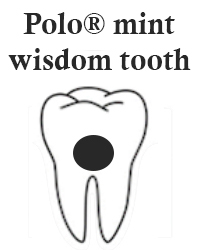An interesting article titled “Identifying the Polo® mint mandibular third molar: a case series” written by Chopra et al. appears in the 2019 edition of Oral Surgery (vol. 12, pp. 89-95). The article discusses lower wisdom teeth that have a perforation in the root where the inferior dental nerve passes through and resemble the classic perforation within the Polo Mint confectionary (the Polo mint is a breath mint with a hole in the middle). These type of wisdom teeth are described as being uncommon, occurring every 1 in 800 cases or less; however they present a high degree of inferior dental nerve injury if they are extracted. The authors state that surgeons may only seen one or two cases in their entire career.

In the article the authors describe a study from 2010 to 2017 where they identified 22 cases of a Polo® mint lower wisdom tooth. All cases were identified using cone beam CT (CBCT) after being referred from an initial panoramic radiograph. The authors retrospectively analyzed the 2D images from the initial panoramic radiograph to determine if any radiographic features were useful to identify a Polo® mint lower wisdom tooth. In 91% (20/22) of the cases superimposition over the inferior dental nerve canal was seen. In 86% (19/22) of the cases banding or darkening of the root was seen. Narrowing and deviation of the inferior dental nerve canal was seen in 59% (13/22) of the cases. It was found in 86% (19/22) of the cases three or more inferior dental nerve injury at risk radiographic signs (the other three cases had two radiographic signs). The authors state
“Cone beam CT appears to be the only reliable way to identify PM8s [a Polo® mint lower wisdom tooth] pre surgery and although radiographic signs can help us identify a potential PM8 [a Polo® mint lower wisdom tooth], the reliability is poor.”
The authors provide an example from one of their cases which shows that it is not possible to always identify 3D structures in 2D images. Thus CBCT must be undertaken to reliably identify a Polo® mint lower wisdom tooth. The authors say that the pros and cons of removal or retaining the Polo® mint lower wisdom tooth must be weighed. Surgical removal should be conducted in cases where there is more than likely to be a benefit to the patient than a complication. In their study half of the patients decided to keep their Polo® mint lower wisdom tooth in place and improve their brushing and flossing and monitor the tooth with their dentist. In the cases that surgery is performed to remove a Polo® mint lower wisdom tooth a surgical handpiece can be used to make surgical cuts within the tooth to allow the freeing of the inferior dental nerve from the tooth and then subsequent extraction. Another option is coronectomy where the coronal portion of the tooth is removed but the root is kept in place. The authors report that in their cases 13 of the 22 patients had a coronectomy performed. The authors also say that piezoelectric surgery is another technique where an instrument produces modulated ultrasonic frequency of 24–29 kHz and a microvibration amplitude between 60 and 200 mm. Piezoelectric surgery was reported as being used in two of the 22 cases.
